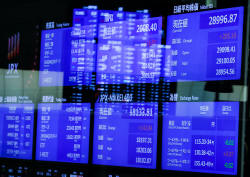Stocks fall further as U.S. yield climb unnerves investors
 Send a link to a friend
Send a link to a friend
 [January 10, 2022] By
Tommy Wilkes [January 10, 2022] By
Tommy Wilkes
LONDON (Reuters) - Stock markets fell again
on Monday as U.S. Treasury yields reached a new two-year high and
investors fretted about the prospect of rising interest rates and a
surge in COVID-19 infections.
Monday's drop follows on from a bruising first week of the year when a
strong signal from the Federal Reserve that it would tighten policy
faster to tackle inflation, and then data showing a strong U.S. labour
market, unnerved investors who had pushed equities to record highs over
the holiday period.
Technology stocks, which have soared the past two years thanks in part
to very low interest rates, led the falls while investors bought into
lower-valued energy and financial shares.
The drop on Monday was limited but across markets.
By 1150 GMT the Euro STOXX dropped 0.37%, Germany's DAX weakened 0.34%
while Britain's FTSE 100 slipped 0.05%.
Futures on Wall Street pointed to a weaker open. The S&P 500 suffered
its worst start to the year since 2016.
Asian shares bucked the trend on Monday. MSCI's broadest index of
Asia-Pacific shares outside Japan added 0.63%
A busy week sees U.S. inflation data due on Wednesday, which analysts
say could show core inflation climbing to its highest in decades at
5.4%, a level that would all but confirm a U.S. rate rise is coming in
March. The season of corporate earnings also kicks off this week with
the big U.S. banks reporting from Friday onwards.

"The persistent rise in consumer inflation could further boost the Fed
hawks, bring them to price a steeper normalization path, and more
importantly fuel the expectation that the Fed should rapidly reduce the
size of its balance sheet to avoid flattening the yield curve while
fighting back inflation," said Ipek Ozkardeskaya, an analyst at
Swissquote.
Ozkardeskaya added that there was "plenty of hawkishness" yet to be
priced into assets.
While the December payrolls number released last week did miss
forecasts, the drop in the jobless rate to just 3.9% and strength in
wages suggested the economy was running short of workers.
Markets quickly shifted to reflect the risks with futures implying a
greater than 70% chance of a rise to 0.25% in March and at least two
more hikes by year end.
[to top of second column] |

Monitors displaying the stock index prices and Japanese yen exchange
rate against the U.S. dollar are seen after the New Year ceremony
marking the opening of trading in 2022 at the Tokyo Stock Exchange
(TSE), amid the coronavirus disease (COVID-19) pandemic, in Tokyo,
Japan January 4, 2022. REUTERS/Issei Kato

FURTHER TO RUN?
Yields on 10-year U.S. Treasury notes hit 1.80% in early trading - levels last
seen in early 2020, having shot up 25 basis points last week in their biggest
move since late 2019. [U/S] The yield later retreasted to 1.77%.
"We think that the increase in long-dated Treasury yields has further to run,"
said Nicholas Farr, an economist at Capital Economics.
"Markets may still be underestimating how far the federal funds rate will rise
in the next few years, so our forecast is for the 10-year yield to rise by
around another 50bp, to 2.25%, by the end of 2023."
Germany's 10-year benchmark yield dropped after an earlier rise to -0.025%,
closer to the 0% level it last traded at in 2019.
The dollar index edged up to 95.911. The greenback has failed to find
significant support from rising Treasury yields.
The euro stood at $1.1323, down 0.3% on the day, while the Japanese yen got a
brief break from its recent bear run to trade up at 115.3.
In commodity markets, gold gained 0.26% to $1,800 an ounce but short of last
week's top of $1,831.
Oil prices dipped but held to recent gains, having climbed 5% last week helped
in part by supply disruptions from the unrest in Kazakhstan and outages in
Libya. [O/R]
Brent slipped slightly to $81.69 a barrel, while U.S. crude traded diown 0.14%
to $78.79.
(Additional reporting by Wayne Cole in Sydney, Editing by William Maclean)
[© 2022 Thomson Reuters. All rights
reserved.]This material may not be published,
broadcast, rewritten or redistributed.
Thompson Reuters is solely responsible for this content.
 |